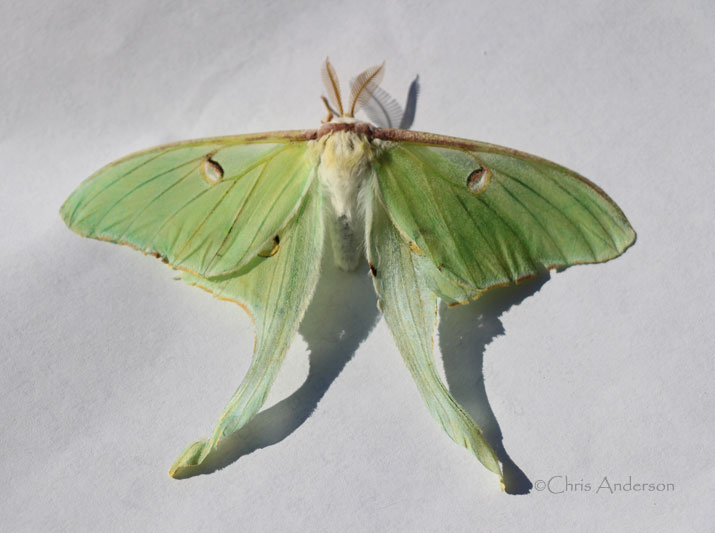|
Leave a light on and an open window on a warm summer night in Virginia and you are likely to wake up to a see a stunning specimen resting on a wall or windowsill. Moths come in a myriad of subtle markings and colorizations, each a fascinating display of ways to blend in with nature.
Compared to our showy day-flying butterflies, moths tend to attract less notice for their beauty, often because we do not get the opportunity to study them closely unless they happen to alight next to an outdoor light or come inside at night. It is difficult to determine the total number of moth species in the Commonwealth* but North Carolina lists 2666 species as of April 2014, far outnumbering the butterfly species for the state. One of our most showy and easily identifiable moths is the lovely luna moth (Actias luna). They belong to the family Saturniidae and, like other large silk moths, have wingspans up to 4 ½ inches. Their wings are a pale green, allowing them to blend into summer tree foliage, and have long graceful tails. Canada marks their farthest range where they typically produce only one generation per summer (referred to as univoltine), whereas in Virginia, they have two generations (bivoltine). In the deep South with longer summers, they may be trivoltine. The caterpillars feed on a relatively diverse list of native trees including the following:
Despite this relatively wide range of host trees, it is a rare delight to see luna moths, particularly in the wild as they typically fly after midnight. The adults lack a mouth so do not feed. They are strong fliers and, once the adults find a mate, the female lays eggs that hatch in about one week. The caterpillars go through five instars, dropping to the leaf litter below the host tree and pupating, emerging as adults and the cycle begins again. Some lepidopterists erect outdoor lighting systems with UV lights and white sheets to attract moths in order to admire their vast array of sizes, colors and body shapes. We are fortunate to live in Virginia with such biodiversity, including the lovely and magical luna moth. References and for more information: https://www.butterfliesandmoths.org/species/Actias-luna http://www.vararespecies.org/ http://www.vararespecies.org/list http://www.carolinanature.com/moths/ http://entnemdept.ufl.edu/creatures/misc/moths/luna_moth.htm https://www.insectidentification.org/insects-by-type-and-region.asp?thisState=Virginia&thisType=Butterfly%20or%20Moth
0 Comments
Your comment will be posted after it is approved.
Leave a Reply. |
Have a blog or blog idea?
Let us know (click) Other Blogs
VA Native Plant Society - click Brenda Clement Jones - click John Muir Laws' Blog - click Megan's Nature Nook - click Categories
All
Archives
September 2023
Blog Administrator:
Kathleen A. VMN since 2018 |
